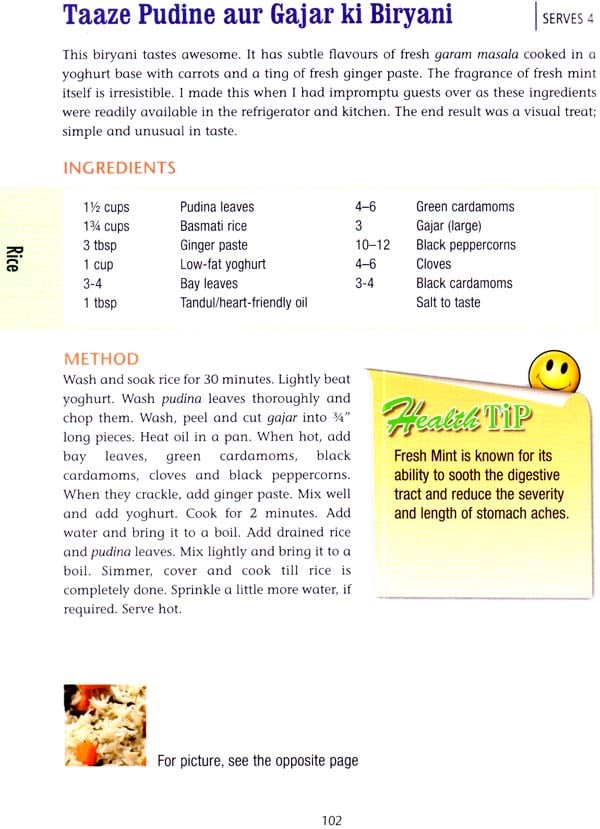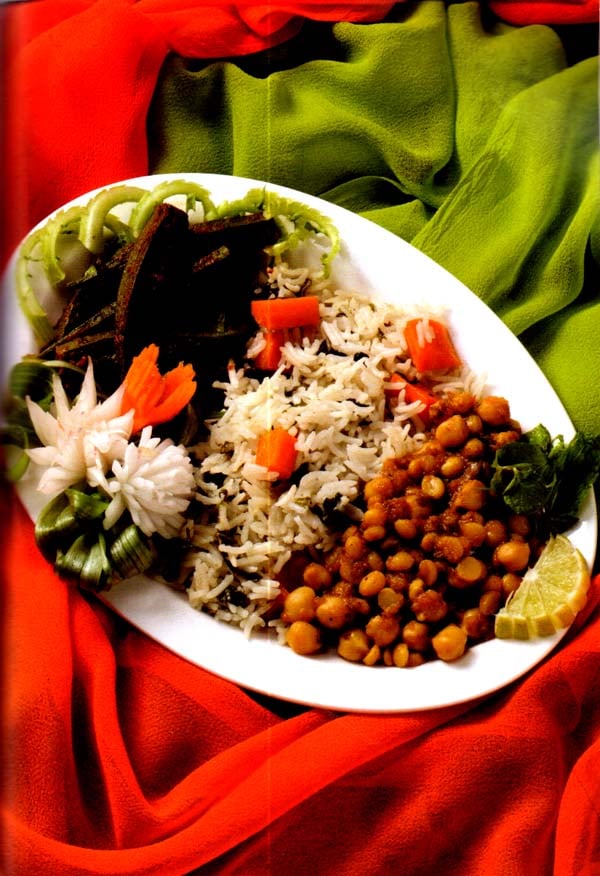
The Heart of The Matter (Eating Healthy Indian Vegetarian Food)
Book Specification
| Item Code: | NAH167 |
| Author: | Gitanjali Gurbaxani |
| Publisher: | Bennett, Coleman and Co. Ltd. |
| Language: | English |
| Edition: | 2011 |
| ISBN: | 9789380942636 |
| Pages: | 144 (Throughout Color Illustration) |
| Cover: | Paperback |
| Other Details | 9 inch x 6.5 inch |
| Weight | 290 gm |
Book Description
About the Book
Gitanjali Gurbaxani is a well-known food consultant and stylist and is also one of Mumbai's pioneer in eggless confectionery. She is a renowned Reiki grandmaster and has been practising Reiki healing in combination with crystal therapy for several years. Gitanjali firmly believes that a carefully designed diet plan can prevent a heart attack and/or avoid its recurrence. She has written columns for the Asian Age, Deccan Chronicle, Femina, Bombay Times, the Indian Express, the Sunday Observer, Mid-Day, Food Talk etc Mid-Day in Mumbai has often referred to her as “Mumbai's Chocolate Queen”. Her passion for eating good Indian vegetarian food in moderation, over the years, has made her rework on a lot of recipes by using minimal oil to suit today's lifestyle, some of which she shares with us in this cookbook.
Preface
The desire to write this book hit me after I noticed several family friends and some close relatives who were unable to alter their lifestyle, change their diet or exercise as per their doctor's advice even after knowing of their heart-related ailments. People who led a lavish and care-free lifestyle, with rich food and liquor flowing in abundance are today avoiding the same due to health reasons. I lost my paternal uncle (who was very dear to me), succumb to a massive heart attack in his deep sleep and it was then that I decided to pen a book to create awareness on how to reduce the calorie intake per day. It also makes it easier to attain and maintain a healthy weight.
Who would have thought you could fight heart diseases, cancer, diabetes and stroke with a fork? What you eat and how much you eat can help reduce your health-related risks. Each plate is a work of art. Simple and elegant, the focus of this book is on eating right. A lot of patience, time and effort has gone into experimenting these dishes to get them just perfect. The healthy vegetarian recipes in this cookbook includes a variety of Indian foods. It puts special emphasis on plant foods such as brightly coloured vegetables, an assortment of fruits, lentils and nuts, and whole grain Indian breads and cereals. I have also used rice bran oil and table spread for cooking these meals, making them genuinely heart friendly.
Unlike other food styling assignments that I have done in the past, this one was very crucial. I made everything as per the recipe, with no added food colour. Unlike other shoots that are done for print and electronic media; where undercooked dishes and artificial colours are used to make them look appealing, here every dish was not only edible but at the same time delicious. My staff and unit ate and relished all that I cooked for lunch after shooting and carried some to their homes too!
I would like to express my gratitude by thanking the people who helped me and encouraged me in the process of writing this book. I would like to thank my parents for their valuable advice, unconditional love, support and constant inspiration. I am exceptionally grateful to Dr BK Goyal for writing the Foreword for this book. I would also like to thank Mrs Mexy Xavier for meticulously taking the photographs. A big thank you to my close friends Mr janak Ram jethmalani, Mr Naresh B Shah ani, Mrs Romy S Wadhwani and Mr Tehmasp Printer for standing by me, when I needed them the most. I would also like to thank Chef Satish Arorn, Director, Food Production, Taj SATS Air Catering Ltd., for being my inspiration and for guiding me on my culinary skills right from my childhood. I am exceptionally grateful to Ms Rupa Dos, Ms Gita Awasthi and Ms Madhulita Mohanty at Times Group Books for believing in the contents of this book. I would like to thank Mr Sanjay jhunjhunwala at Foods, Fats & Fertilizers Ltd., for his confidence and support. Last but not the least, I am much obliged to Mrs Seema and Mr Sushi! Goenka, without whose support this book could never have become a reality.
I would also like to thank Mr Anil Pawar, Mr Ashish Bairagra, Mr Dilip Tcrnbe, Mr Hemal Putel, Ms Karishma jnin, Mr Lal Singh, Chef Mangala C Nijai; Ms Minoshka Xavier, Mr Rajiv Parackal, Mr Pandurang Ghadigaonkar, Mrs Romy S Wadhwani, Mr Tukaram Shetty, Mrs Usha C Renake, my family, friends, office staff and domestic staff, who have helped me put this book together. A big “Thank You” to Ms Abhilasha Aggarwal, at the Times Group Books for giving us these wonderful page layouts.
Foreword
There are numerous and distinct disorders that relate to heart. These include angina, heart attack and heart failure, rheumatic heart disease and high blood pressure or hypertension. The heart is merely not a pump. It is the head spring of every feeling and emotion, whether it is delight and excitement or gloominess and frustration. Several illnesses such as high blood pressure, diabetes, high blood cholesterol and obesity are also known to be the contributing factors for heart ailments. Mental and emotional tenseness disrupts the emotional heart, where as, a junk diet, unhealthy lifestyle and absence of physical exercises weakens the physical heart. Smoking may accentuate coronary spasms, where the blood vessels of the heart are pinched or narrowed, causing chest pain or a heart attack.
Less than a century ago, heart diseases were extremely rare. However, today it is the cause of death of more people in the world than all other deadly diseases taken together. The main cause of heart troubles is hurry, curry and worry. Curry here refers to fatty foods. Heart diseases are found to be more rampant among non vegetarians, while vegetarians are not prone to heart ailments to the same extent. This is because of higher percentage of fats in non-vegetarian food, which increases the cholesterol in the blood. Excess consumption of oily and fatty foods, ice creams and lack of adequate exercise are the main reasons for heart ailments. Dark chocolate contains flavonol antioxidants that are useful in lowering blood pressure and preventing several diseases. Worry can cause high blood pressure and individual response to stress may be a contributing factor in other disorders.
If you have diabetes, monitoring your blood sugar is an important part of your treatment p1an. But there's more. You also need to pay close attention to what's happening to your heart and blood vessels. That's because cardiovascular disease is the most common and most serious complication of diabetes. You are two to four times more likely to have a heart attack or stroke than you would be if you did not have diabetes.
The best way to keep away from any cardiac problem is to follow this five point plan. Maintain a healthy weight, exercise regularly, have your blood pressure checked regularly, keep your diabetes under control and monitor your cholesterol levels. Eating habits of an average Indian are one of the reasons for increase in heart-related problems. Eat a low-fat, low-cholesterol diet. Limit your intake of fats and increase your intake of low fat foods. Eat a lot of fruits, vegetables and whole grain. This book The Heart of the Matter - Eating Healthy Indian Vegetarian Food by Ms Gitanjali Gurbaxani is a low-fat, low-calorie cookbook, which has the wholesomeness of healthy homemade food which is light on stomach. Gitanjali, known for her eggless desserts, is a vegetarian herself and has the creme de la creme of society as her clients. She is a gourmet cook and a connoisseur of good food, that is healthy and tasty. I wish her good luck and success with this cookbook.
Contents
| Preface | 9 |
| Foreward | 11 |
| Importance of a Vegetarian Diet for a Healthy Heart | 13 |
| Energy Foods for a Healthy Body | 15 |
| Eat Regularly to Stay Fit | 17 |
| SOUPS | 19 |
| Broccoli aur Badam ka Shorba | 20 |
| Matar ka Shorba | 23 |
| Taaze Tamatar aur Kali Mirch ka Soup | 24 |
| Taaze Dhaniye aur Gajar ka Shorba | 27 |
| Taazi Makai aur Gajar ka Shorba | 28 |
| Palak ka Soup | 30 |
| SNACKS | 31 |
| Aloo aur Paneer ki Tikki | 32 |
| Arvi ke Seekh Kebab | 33 |
| Haryali Paneer Tikka | 36 |
| Paneer Tikka | 37 |
| Batata Poha | 38 |
| Sukha Aloo Pyaaz ke Masale Mein | 40 |
| MAIN COURSE | 41 |
| Alur Dom | 42 |
| Baghara Baingan | 43 |
| Bhindi aur Aloo ki Subzi | 44 |
| Bhindi Jeere aur Saunf ke Masale Mein | 45 |
| Dahi Wali Bhindi | 46 |
| Kashmiri Dum Aloo | 48 |
| Khatta Meetha Batata | 49 |
| Karela Dahiwala | 50 |
| Khatte Meethe Baingan | 52 |
| Lauki aur Shimla Mirch ki Subzi | 53 |
| Lajawab Karele | 54 |
| Makai Palak aur Milwa Subzi | 56 |
| Methi aur Kele ki Bhaji | 57 |
| Lazedaar Matar Paneer | 58 |
| Matar aur Khumb ki Subzi | 60 |
| Mili hui Subziyan Pyaz ke Masale Mein | 61 |
| Masaledaar Gobhi | 62 |
| Paneer Tamatar ke Masale Mein | 64 |
| Rasogulle ke Kofte | 66 |
| Paneer Achaari | 68 |
| Paneer Jalfrezi | 69 |
| Shahi Bhindi Paneer Korma | 70 |
| Soya bean ki Subzi | 71 |
| Bharwan Parwal | 74 |
| DAL | 75 |
| Aam Dal | 76 |
| Dal Palak Wali | 80 |
| Mughlai-style Chana | 82 |
| Khatti Meethi Tuvar Dal | 83 |
| Ghugni | 84 |
| Paraati Chana | 86 |
| Rajasthani Panchmel Dal | 87 |
| Moong aur Tuvar ki Dal Mili Hui | 88 |
| Rajma Masala | 90 |
| Vegetable Dhansak | 92 |
| RICE | 95 |
| Brown Rice | 96 |
| Patta Gobhi ki Biryani | 97 |
| Matar aur Gobhi ki Khichdi | 98 |
| Shahi Baingan Pulao | 100 |
| Taaze Khumb ke Pulao | 101 |
| Taaze Pudine aur Gajar ki Biryani | 102 |
| Taaze Tamatar ke Chawal | 104 |
| INDIAN BREADS | 107 |
| Aloo ka Paratha | 108 |
| Missi Roti | 110 |
| Matar aur Bajre ki Roti | 111 |
| Gajar aur jowar ki Masalewale Roti | 112 |
| Palak aur Til ke Parathe | 114 |
| Thalipeeth | 116 |
| Phool Gobhi ke Parathe | 118 |
| ACCOMPANIMENTS | 119 |
| Gajar aur Matar ka Salad | 120 |
| Phool Gobhi ka Raita | 122 |
| Seke Hue Bhutte ka Salad | 124 |
| Taaze Phal ka Raita | 126 |
| SWEET ENDINGS | 129 |
| Aam ka Shrikhand | 130 |
| Badam ki Phirni | 132 |
| Seka Hua Chocomosa | 133 |
| Chatpata Fruit Salad | 134 |
| Kachhi Kairi ka Malpua | 136 |
| Kele ka Sheera | 137 |
| Glossary page | 138 |







